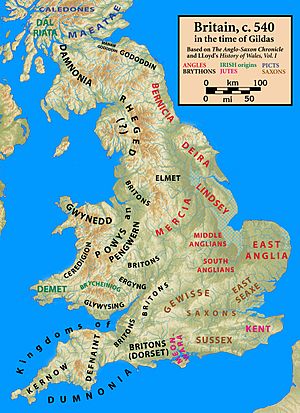Sub-Roman Britain facts for kids
Sub-Roman Britain is the name for Britain after the Roman army left. This period usually lasted from about 410 AD until the early 600s. During this time, Britain slowly changed from being Roman to becoming Anglo-Saxon.
Contents
A Changing Land
After controlling Britain for about 400 years, the Romans left Roman Britain in the early 400s. But even after they left, many Roman ways of life and a type of Latin language stayed for another 200 years.
At the same time, groups called the Anglo-Saxons started moving into Britain. They came from northern Germany and the Jutland peninsula (which is now part of Denmark).
Fighting the Invaders
At first, the Romano-British people (who had adopted Roman culture) fought back against the Anglo-Saxons. There's a famous story about a mythical leader, King Arthur, who helped stop the invasion. Many historians think that a real leader named Ambrosius Aurelianus might have been the inspiration for King Arthur.
Ambrosius Aurelianus was a strong Romano-British leader around the mid-400s. He was known for fighting against the Saxons. Some people believe he led the Romano-British forces in a big battle called the Battle of Badon Hill around 500 AD, where they won a major victory.
Anglo-Saxon Expansion
Even with the early victories, the Anglo-Saxons slowly gained more land. By the end of the 400s, they controlled eastern England. In the mid-500s, they started moving into the middle parts of England, known as the English Midlands.
Then, in the 600s, they expanded even more into the south-west and north of England. The parts of southern Britain that were not conquered, especially Wales and nearby areas, kept their Romano-British culture. They also kept their Christianity religion.
The Name "Welsh"
Some Anglo-Saxon history books called the Romano-British people "Welsh." This word comes from an Old English word that means 'foreigner'. Historically, Wales was known as North Wales, and the south-western part of Britain was called West Wales.
Surviving Roman Towns
Recent discoveries show that some Roman-British towns continued to be lived in during these 200 years. Towns near an old Roman road called Watling Street, like Viriconium (Wroxeter) and Venta (Caerwent), were still active.
One of the last Sub-Roman cities to be taken over by the Anglo-Saxons was Deva Victrix (Chester). People there were still using Roman amphoras (large jars) until about 616 AD. The city of Chester may have survived longer because of its strong Chester city walls. These walls had protected the city since the Roman fort was built there in 79 AD.
Archaeological finds in places like Tintagel also show that some Romanized Britons, who spoke their own kind of Latin, lived on until the late 600s.
Related pages
Images for kids
-
Barbury Castle, a 6th-century hill fort near Swindon in South West England
See also
 In Spanish: Britania posromana para niños
In Spanish: Britania posromana para niños




